
I’ve struggled with spiritual burnout a few times over the last several years. But, I’ve learned a lot from those experiences, and I’m excited to share what I now know with you!
Although I was exposed to religion as a kid I didn’t grow up particularly religious. And I was in my thirties before I understood one could be spiritual without actually belonging to an organized religion. If asked my beliefs today, I would describe myself as spiritual but not religious. And I recognize my journey of personal development has been one of not only mental, physical, and emotional growth and healing, but also spiritual growth and healing.
I’ve worked with clients for whom a specific religious structure is a core part of their life, and clients who struggle to identify with the term spiritual. Regardless of where you fall on that spectrum, I believe we all have the potential to experience spiritual burnout as we work to build our best lives.
In this post I’ll be using languaging that feels authentic to me, if it doesn’t resonate with you, try to focus on the concepts, not the specific words I use to describe them.
What is spiritual burnout
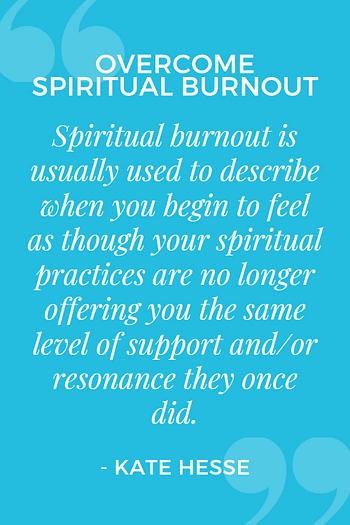 First, let’s talk about what spiritual burnout is.
First, let’s talk about what spiritual burnout is.
You can learn more about burnout in general here and here. In an nutshell, when you spend your physical, mental, or emotional reserves faster than you replenish them, eventually your reserves run dry and you experience burnout.
Spiritual burnout specifically is usually used to describe when you begin to feel as though your spiritual practices are no longer offering you the same level of support or resonance they once did.
As with any other form of burnout, the way this will manifest is as unique as you are. For some, it causes them to question their faith, for others, they may find their spiritual practices begin to feel hollow, or they may find they struggle in other areas of their lives if they don’t receive the same level of restoration from their spiritual practice as they once did.
Regardless of how it manifests, just like any other form of burnout, continuing to do the same things you’ve always done will keep you in burnout instead of offering you the opportunity to replenish and recover from it.
There’s nothing wrong with you
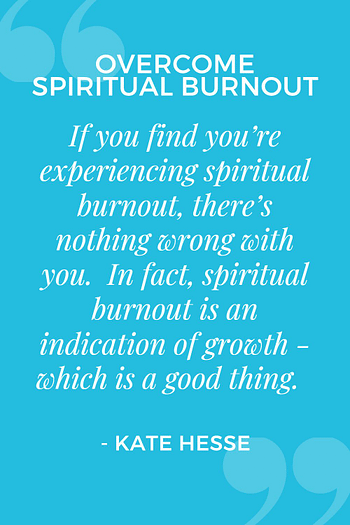 If you find you’re experiencing spiritual burnout, first, I want to assure you, there’s nothing wrong with you. In fact, I believe spiritual burnout is an indication of growth – which is a good thing.
If you find you’re experiencing spiritual burnout, first, I want to assure you, there’s nothing wrong with you. In fact, I believe spiritual burnout is an indication of growth – which is a good thing.
Sometimes it happens because we’ve been pushing and growing so quickly we haven’t given ourselves time to fully integrate and process. Think of this as the equivalent of blowing a fuse by running too many appliances at once.
And sometimes you experience spiritual burnout when you realize you’ve outgrown some of your old beliefs but you aren’t sure how to move on from them.
Often these beliefs are ones you inherited or absorbed from society, your religion, your family, friends, or another external source. Just like any other beliefs we inherit or absorb, as we get to know ourselves better, we may discover something we’ve always just gone along with without questioning suddenly just doesn’t make sense with everything else we believe.
You don’t have to throw the baby out with the bathwater – but you can if you want to
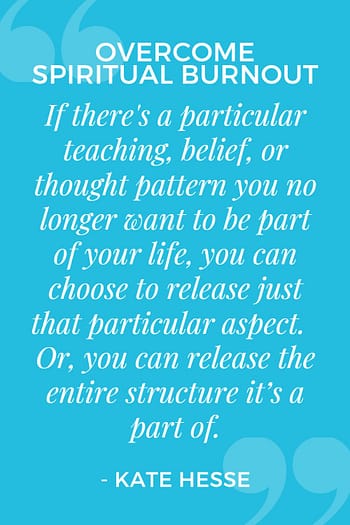 If you discover that inherited or absorbed beliefs which you no longer align with are part of your spiritual burnout, AND if they’re part of a larger spiritual or religious practice, you don’t have to throw the baby out with the bathwater.
If you discover that inherited or absorbed beliefs which you no longer align with are part of your spiritual burnout, AND if they’re part of a larger spiritual or religious practice, you don’t have to throw the baby out with the bathwater.
You’ve probably heard me say it before, you have the right to take what resonates and leave the rest.
If there is a particular teaching, belief, or thought pattern you no longer want to be part of your life, you can choose to release just that particular aspect. Or, you can choose to release the entire structure that it’s a part of. It’s your choice, and only you know what’s right for you.
What are you ready to release?
We’re going to dive into some self-reflection question – you can get these and other techniques to overcome spiritual burnout using the companion worksheet – get it using the form below.
Take some time to really zoom in and ask yourself these questions:
- What beliefs feel out of alignment to me?
- Why am I struggling with these beliefs?
- How does releasing these beliefs change the way I view my overall spiritual understanding?
- What belief or beliefs do I want to replace these unaligned beliefs with?
Use whatever technique works best for you when it comes to self reflection. You could ponder these questions during meditations, while on a walk, or in a journal.
If you’re new to this type of self reflection, when do you do your best thinking? When do you have aha moments on any project you’re working on? It might be in the shower, it might be while you’re commuting to work. Whatever it is, ask yourself these questions as you move into that activity to direct your mind toward exploring them when you’re most apt to have insight.
This is also a great time to tap into your intuition – I’ve got a powerful journaling exercise to tap into your intuition in my Intuition 101 course – don’t forget podcast listeners save 25% with code PODCAST!
It’s ok to question your beliefs
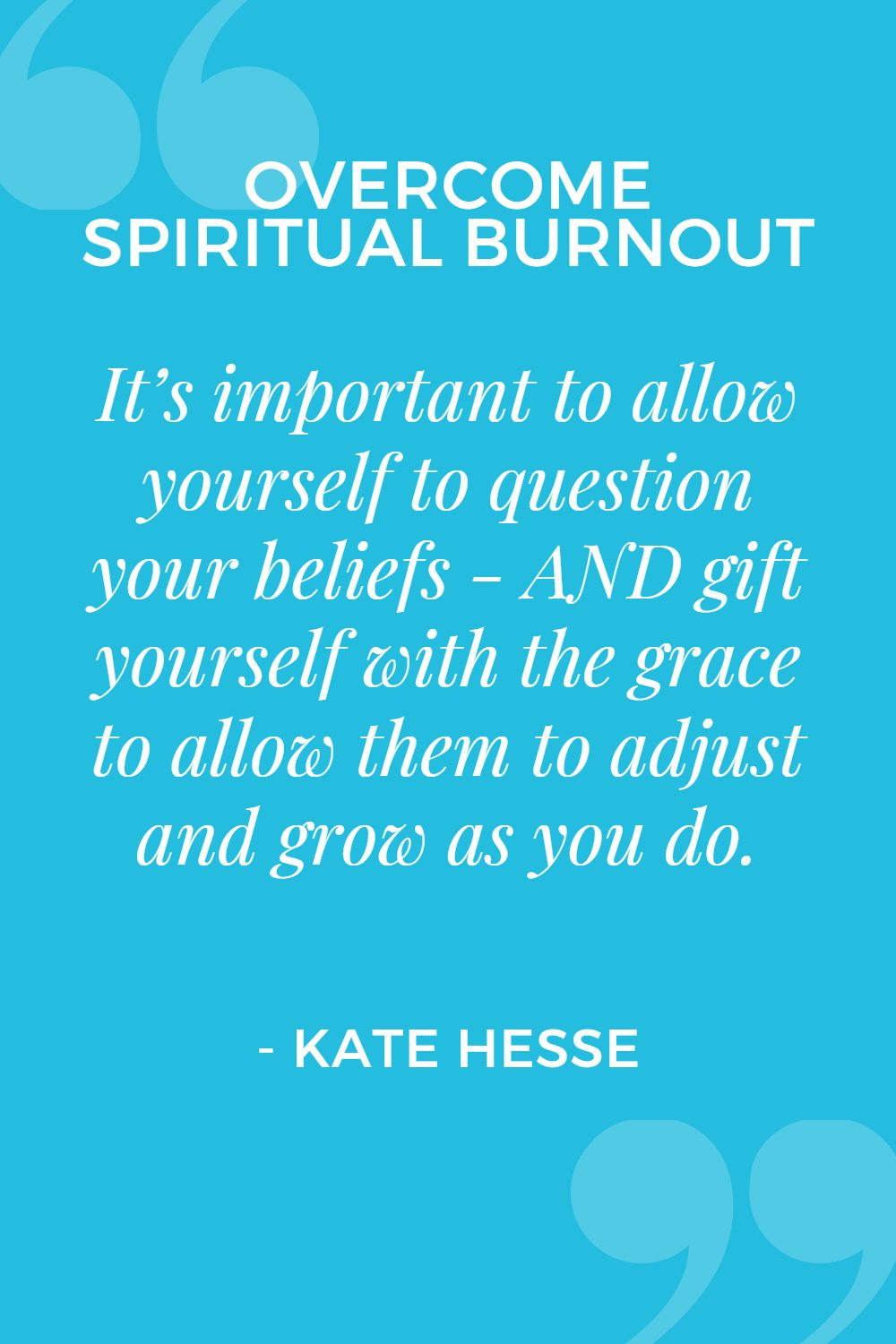 It’s important to allow yourself to question your beliefs – AND gift yourself with the grace to allow them to adjust and grow as you do.
It’s important to allow yourself to question your beliefs – AND gift yourself with the grace to allow them to adjust and grow as you do.
However, spiritual beliefs can be part of the bedrock you’ve built your life on. I recognize it can feel scary to even question them, much less consider releasing them.
I encourage you to think about each choice you make as a fork in a path, if you find you’ve released something you’d like to have back, you simply walk back down the path and take the alternate road at the fork.
It’s ok to experiment – maybe that looks like going to a new church one week. Maybe that looks like trying chi gong instead of yoga for a week. Perhaps it means reading books written by teachers from a variety of spiritual backgrounds. Again, the way you explore and experiment is as unique as you are – how do you like to learn and explore in other aspects of your life?
Allow yourself to make changes in your spiritual practice
Yoga is an important part of my spiritual practice.
For several years leading up to my yoga teacher training I attended a yoga class three to five times a week. My physical practice intensified during my teacher training, with nearly daily asana either at home or in class throughout the eight month program.
And then I completed my yoga teacher training and I didn’t get on my mat for almost three months. I was experiencing my first round of spiritual burnout. I had neither the interest nor the energy for a physical yoga practice.
But here’s the thing. Asana, the physical yoga poses, is just one part of the eight limbed practice of yoga. That left me with seven other ways to explore yoga off the mat.
At first I struggled with not practicing – I felt like I “should” be practicing asana – I did just finish a teacher training program. But as I began to release that should, I opened myself up to other ways to explore yoga off the mat.
And the result, not only do I have a daily asana practice again, but I also deepened my spiritual practice, connection to, and understanding of yoga by spending several months focusing on the other limbs of yoga. I explored not only the different limbs but also how to incorporate them into all aspects of my life – not just my designated “yoga time”.
What other tools or techniques might work for you?
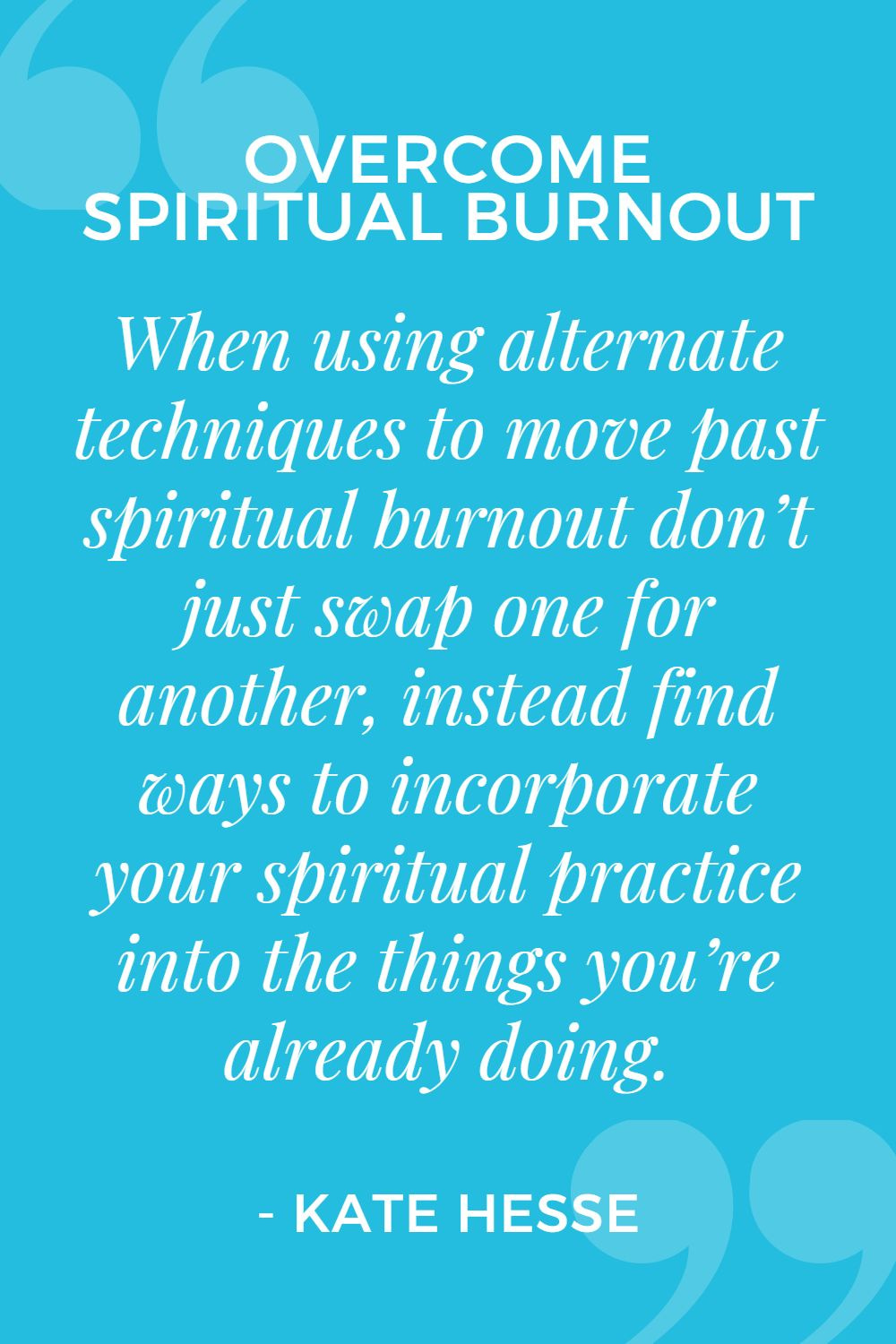 I’ve found the best way to use alternative tools and techniques to move past spiritual burnout is not to just swap one for another, but to find ways to incorporate them into the things you’re already doing.
I’ve found the best way to use alternative tools and techniques to move past spiritual burnout is not to just swap one for another, but to find ways to incorporate them into the things you’re already doing.
Maybe you find your daily bible journaling practice just isn’t working for you anymore. Perhaps instead you begin to recite your favorite passages in the shower each morning as a way to connect with the words you find most potent and powerful for you right now.
Or maybe you struggle to identify as spiritual but you begin to notice when you sit down to write in your gratitude journal nothing comes to you. What if you tried simply thanking each part of your body for working as well as it does as you wash it during your shower.
These changes don’t have to be permanent
As with my asana practice, you may find after a time you’re ready to return to the tool or technique you stepped away from. Or you may not. And that’s ok.
When I was ready to get back on my mat, I noticed I started to miss that part of my practice. I started with a class here and there, and slowly built my way back up to the point where I’m at now – a twice daily practice most days. The key was removing any pressure to be at a certain stage or practice in a certain way.
Listen to your own whispers, allow yourself to experiment, and recognize that the tools you use to explore your spiritual world may evolve right along with you.
Give yourself the grace to move at the pace that’s right for you
A couple of years ago I was deep into my healing journey. I’d filled my toolkit with enough tools and techniques I was able to make some rapid progress in releasing old stories and beliefs, healing old wounds, and incorporating new knowledge, awareness, and beliefs to fill the void they left.
And it felt awesome – to be moving so much energy. To be releasing so much old gunk. To be zipping along at a pace I could never have imagined.
BUT – I wasn’t giving myself time for integration. I was so focused on moving out the next thing, releasing the next bunch of stagnant energy, and healing the next old trauma that surfaced. And suddenly I hit a wall. It all felt like too much. I could continue to work on healing and move the energy, but it just felt heavy and hard and like so so so much more work than I had the energy for.
I had to slow what I was doing WAY down and give myself the time and the space to integrate everything I’d already done before I was ready to dive back in to do more healing, releasing, and growing.
Your spiritual growth won’t always be constant
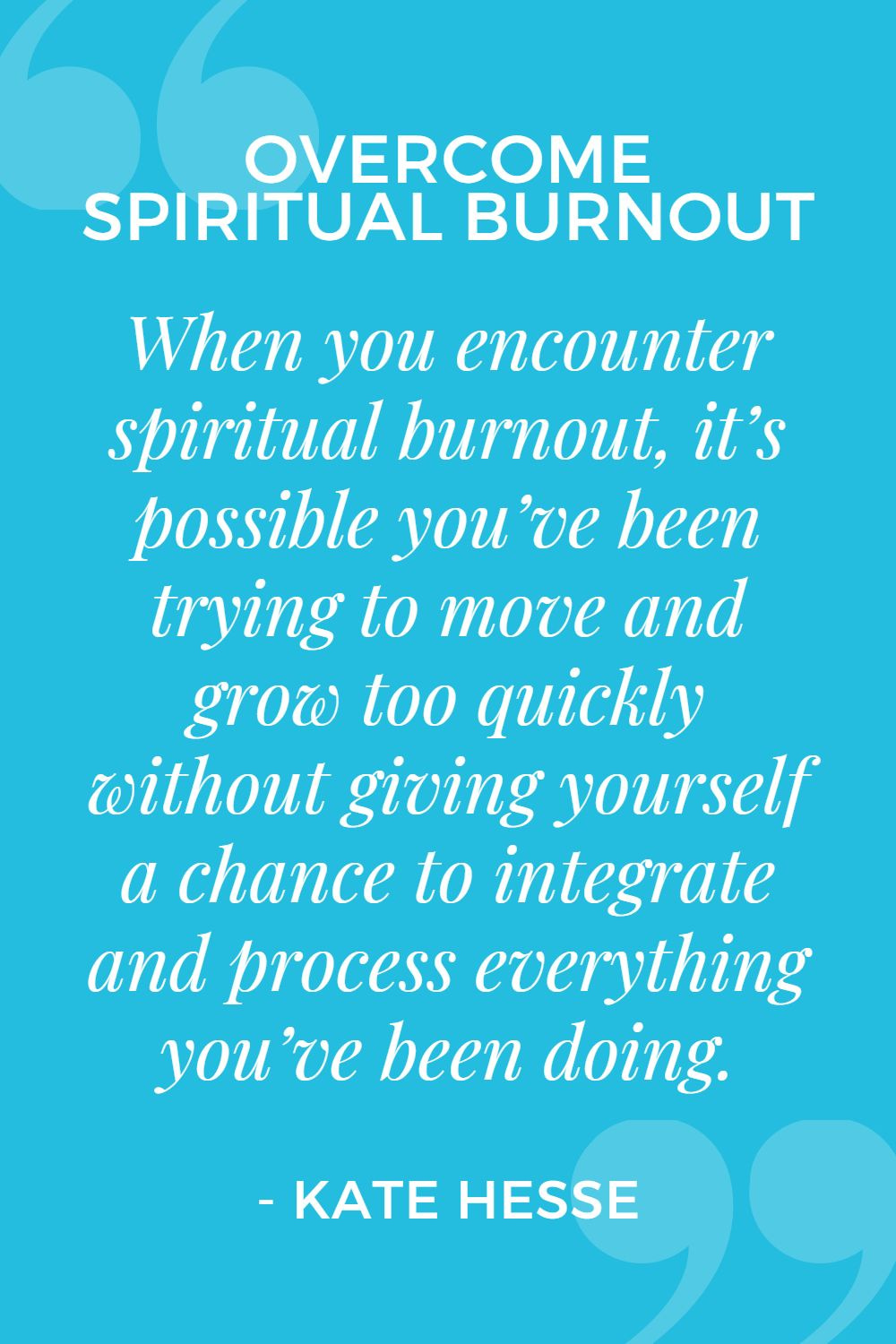 When you encounter spiritual burnout, it’s possible you’ve been trying to move and grow too quickly without giving yourself a chance to integrate and process everything you’ve been doing.
When you encounter spiritual burnout, it’s possible you’ve been trying to move and grow too quickly without giving yourself a chance to integrate and process everything you’ve been doing.
Think about a tongue twister – you’re probably familiar with “how much wood could a woodchuck chuck if a woodchuck could chuck wood?”. Let’s do an experiment. See how quickly you can repeat a tongue twister out loud. Then see how quickly you can repeat it in your head.
Ok, did you give it a try? Chance are you could repeat it in your head much faster than aloud. Your mouth just couldn’t keep up with the words you were trying to get out.
I like to think of the healing and growing too quickly like this. Your body just can’t move at the pace you’d like it to go. So you need to slow down a little and let everything integrate so you’re back in harmony.
Stress management & resilience building tools for spiritual burnout
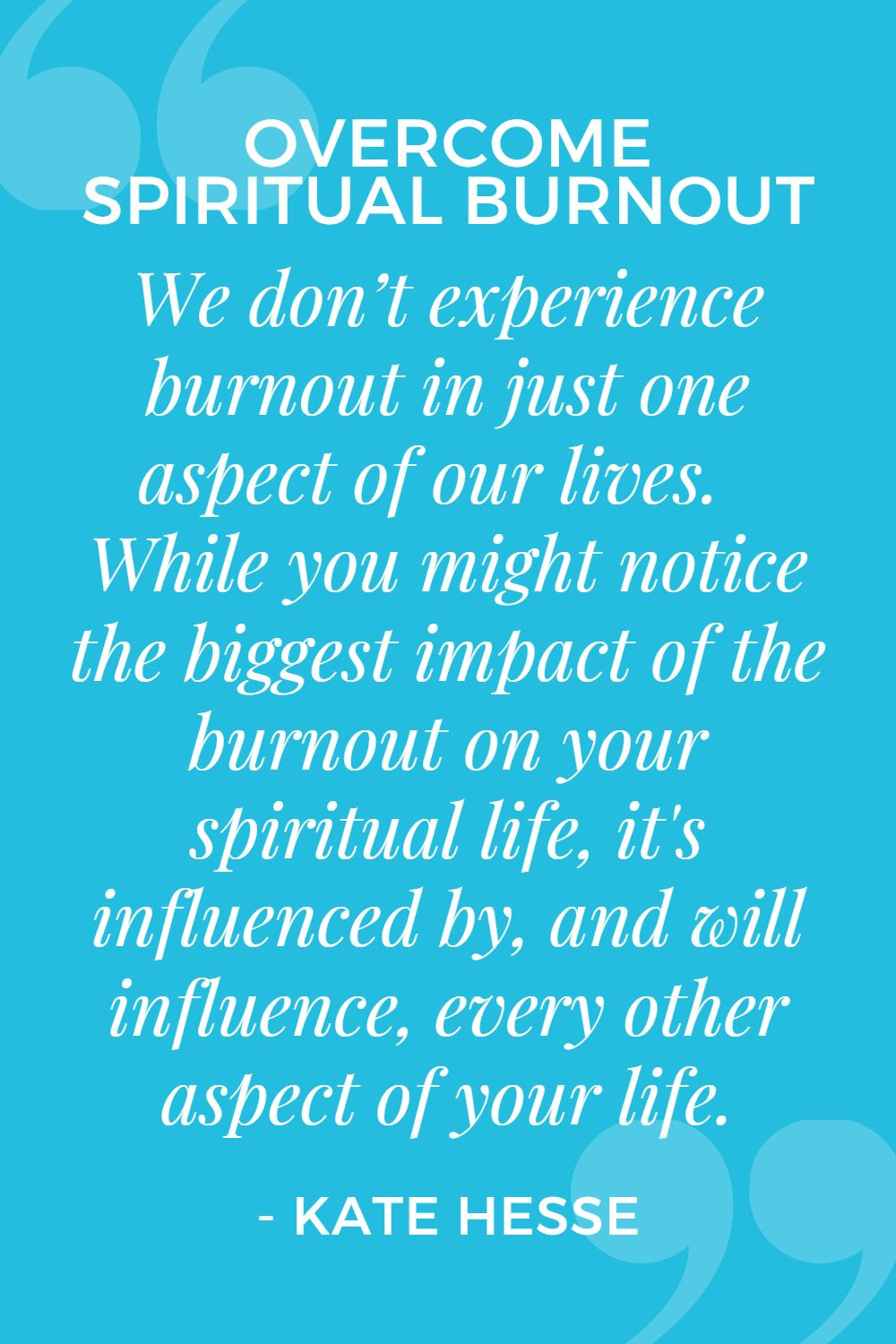 I’ve talked a lot about stress management and resilience building on the podcast. And it applies here the same as it does in any other situation of burnout.
I’ve talked a lot about stress management and resilience building on the podcast. And it applies here the same as it does in any other situation of burnout.
We don’t experience burnout in just a single aspect of our lives and spiritual burnout is no different.
While you might notice the biggest impact of the burnout on your spiritual life, it’s influenced by, and will influence, every other aspect of your life.
Sometimes we’re overwhelmed in another aspect of our lives and it takes all of our resilience to cope with that, leaving little to deal with what might otherwise be a more minor additional burden in our spiritual lives.
Or perhaps your spiritual life is the source of the burnout and it takes so much energy to process what you’re experiencing that you don’t have enough left to take care of yourself in any other way.
Whatever the form of burnout, there are two steps to recovering:
- First – identify what’s draining your energy faster than normal, and find a way to reduce that drain.
- Second – increase your self care to begin replenishing your reserves faster than you drain them.
Create a consistent, sufficient, and sustainable self-care action plan
 Take stock of what is causing your burnout. How can you turn down the dial on that activity? Can you scale back or pause the activities which are the proximate cause of your burnout – like when I stopped practicing asana.
Take stock of what is causing your burnout. How can you turn down the dial on that activity? Can you scale back or pause the activities which are the proximate cause of your burnout – like when I stopped practicing asana.
Now figure out what self-care activities will offer you the most replenishment. And schedule them into your day – don’t just make them items on your to-do list, but add them to your calendar as non-negotiables.
If you’re not sure where to start identifying the right self-care activities for you, grab your copy of my Free Self-Care Toolkit.
And offer yourself the grace to focus on restoring and replenishing. So often we confuse self-work with self-care – which means we put so much energy into learning and growing we miss actually refilling our reserves. This is a great way to end up in burnout – even though you think you’re doing all the right things!
If you’re not sure you fully understand the difference between self-work and self-care, check out Episode 4 of the podcast where I do a deep dive on the differences!
So how do you overcome spiritual burnout?
Moving past spiritual burnout starts with identifying the cause or causes and then finding the most authentic way for you to respond to them. You might need to release a belief or set of beliefs you no longer find are in alignment with you. You might need to find new tools and techniques for your spiritual practice. Or you might need to slow things down to allow yourself to integrate and restore.
There are so many different reasons spiritual burnout can manifest in your life, and there are so many different ways it can show up. I’ve put together a companion worksheet for this post to help you explore the different causes of spiritual burnout and how to help yourself recover from them. You can get your copy using the form below.
And remember – living your best life isn’t about changing your life – it’s about changing the way you show up for your life!
Show Notes
Mentioned in this Episode
Learn More and Register for Intuition 101 and save 25% with code PODCAST
Get your Free Self-Care Toolkit
Learn more about the difference between self-care and self-work
Schedule a Personal Roadmap Discovery Session.
Get on the VIP list to have all podcast worksheets delivered to your inbox each Tuesday morning.
Submit your question to be featured on a future episode.
Related
Leave a Reply Cancel reply
This site uses Akismet to reduce spam. Learn how your comment data is processed.